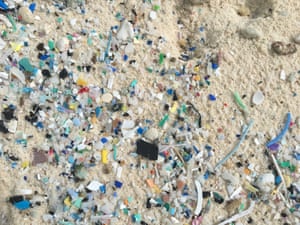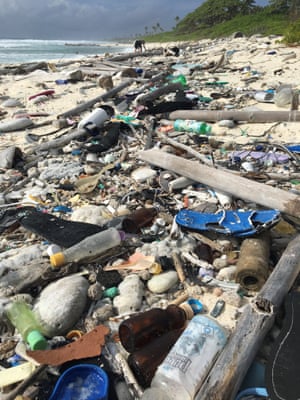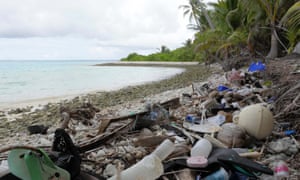Debris on Cocos (Keeling) Islands was mostly bottles, cutlery, bags and straws, but also included 977,000 shoes, study says
On the beaches of the tiny Cocos (Keeling) Islands, population 600,
marine scientists found 977,000 shoes and 373,000 toothbrushes.
A comprehensive survey of debris on the islands – among the most
remote places on Earth, in the Indian Ocean – has found a staggering
amount of rubbish washed ashore. This included 414m pieces of plastic,
weighing 238 tonnes.The study, published in the journal Nature, concluded the volume of debris points to the exponential increase of global plastic polluting the world’s oceans and “highlights a worrying trend in the production and discharge of single-use products”.
“Islands such as these are like canaries in a coal mine and it’s increasingly urgent that we act on the warnings they are giving us. Plastic pollution is now ubiquitous in our oceans, and remote islands are an ideal place to get an objective view of the volume of plastic debris now circling the globe,” Lavers said.
The study found the quantity of debris buried up to 10cm beneath the beach was 26 times greater than the amount visible; that previous surveys that only assessed surface garbage might have “drastically underestimated the scale of debris accumulation”.

While most of the debris found on Henderson Island was fishing-related, on the Cocos (Keeling) Islands, the plastic was mostly single-use items such as bottles, plastic cutlery, bags and straws.
“Our excessive and unrelenting demand for plastics, coupled with ineffective policy and waste management, has resulted in myriad negative effects on marine, freshwater, and terrestrial environments, including entanglement and ingestion of debris, and subsequent exposure to plastic-associated chemicals,” the report said.
“The Cocos (Keeling) Islands [are] touted as ‘Australia’s last unspoilt paradise’, with tourism a primary source of income for the local community. However, the impact of debris on tourism and [their] beaches is increasingly difficult to avoid.
Items such as shoes and toothbrushes were found in such large quantities, the researchers said it would take the local population about 4,000 years to generate the same amount of waste.
The local community has struggled to find an appropriate landfill site, or other ways to properly dispose of the garbage.
“In the absence of rapid and meaningful change, anthropogenic debris will accumulate on beaches, with impacts increasingly felt by biodiversity and marine plastic mitigation will remain a perpetual game of catch-up,” the report found.
“Mitigation initiatives, including policy, should be mindful of the challenges faced by remote islands, and the communities that reside there.”

“An estimated 12.7m tonnes of plastic entered our oceans in 2010 alone, with around 40% of plastics entering the waste stream in the same year they’re produced,” Finger said.
“As a result of the growth in single-use consumer plastics, it’s estimated there are now 5.25 trillion pieces of ocean plastic debris.
“The scale of the problem means cleaning up our oceans is currently not possible, and cleaning beaches once they are polluted with plastic is time consuming, costly, and needs to be regularly repeated as thousands of new pieces of plastic wash up each day.”

No comments:
Post a Comment